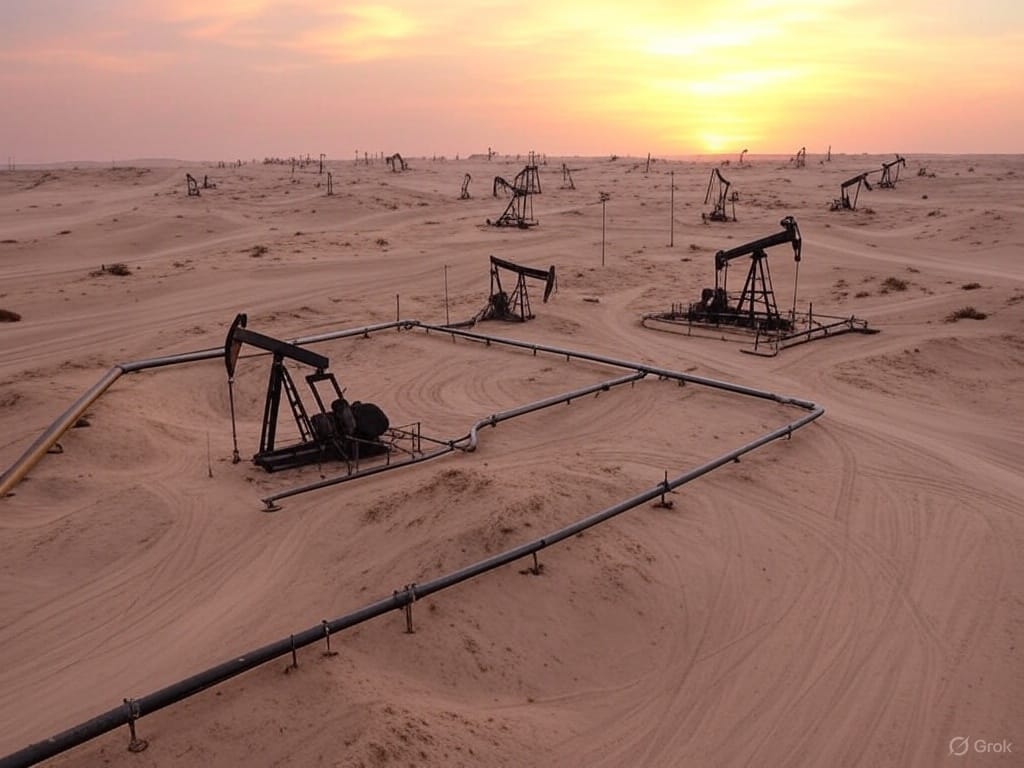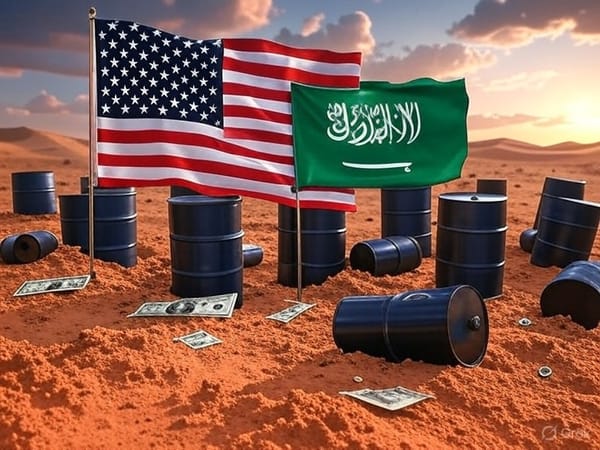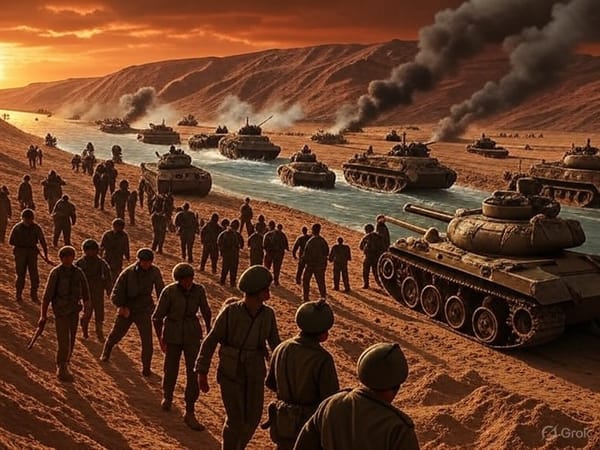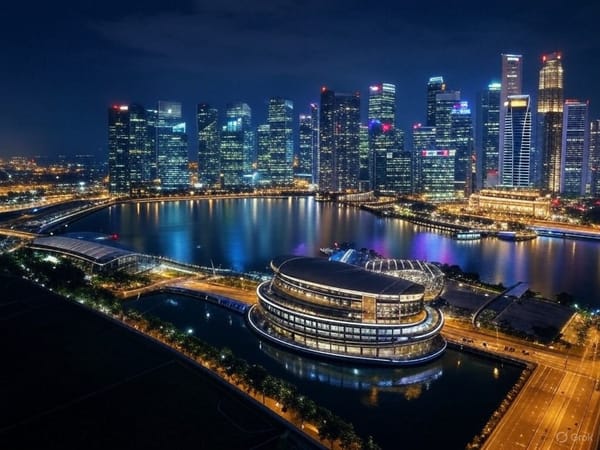Oil, Sand, and Blood
Beneath the Middle East's shifting sands lies a volatile mix of colonial legacies, oil-driven rivalries, and human suffering that continues to shape global politics.

The Middle East stands as one of the most volatile and consequential regions in the world. Its deserts have borne witness to ancient empires, religious awakenings, and, in more recent centuries, a scramble for power that has left an indelible mark on global politics. Beneath the shifting sands lies a resource that has fueled both prosperity and conflict: oil. Coupled with arbitrarily drawn colonial borders and the rivalries they spawned, the story of the Middle East is one of oil, sand, and blood—a geopolitical flashpoint that continues to shape the modern world. In this deep dive, we’ll unpack the historical roots of these conflicts and explore the high-stakes rivalries driving the region’s present and future.
The Legacy of Colonial Borders
To understand the modern Middle East, one must first rewind to the early 20th century, when the region’s geopolitical landscape was redrawn by European powers. The collapse of the Ottoman Empire after World War I left a power vacuum that Britain and France eagerly filled. The 1916 Sykes-Picot Agreement, a secret deal between these two nations, carved up the Ottoman territories into spheres of influence with little regard for ethnic, religious, or cultural realities on the ground.
These colonial borders—often straight lines drawn on maps in distant capitals—sowed the seeds of discord. Iraq, for instance, emerged as an uneasy amalgamation of Sunni, Shia, and Kurdish populations, each with distinct identities and aspirations. Syria, Lebanon, and Jordan faced similar fates, their boundaries reflecting imperial convenience rather than local coherence. The consequences were immediate: resentment toward foreign meddling fueled nationalist movements, while internal divisions created fault lines that would later erupt into conflict.
The arbitrary nature of these borders wasn’t just a historical footnote—it remains a live wire today. The Islamic State’s brief caliphate in the 2010s, for example, sought to erase the Sykes-Picot lines, appealing to a sense of unity that transcended colonial divisions. Though its reign was short-lived, the sentiment it tapped into lingers, a reminder of how deeply the past shapes the present.
The Black Gold Rush
If colonial borders lit the fuse, oil poured fuel on the fire. The discovery of vast petroleum reserves in the early 20th century transformed the Middle East from a strategic backwater into a global prize. Persia (modern-day Iran) struck oil in 1908, followed by Saudi Arabia in the 1930s and the Gulf states shortly after. By mid-century, the region was home to the world’s largest known reserves, a treasure trove that would dictate the course of international relations.
Oil didn’t just bring wealth—it brought power. For Western nations, securing access to Middle Eastern oil became a matter of national security. The United States and Britain cultivated alliances with oil-rich monarchies, often turning a blind eye to authoritarian rule in exchange for stable supply lines. The 1945 meeting between President Franklin D. Roosevelt and Saudi King Abdulaziz aboard the USS Quincy cemented this quid pro quo, laying the foundation for a decades-long partnership.
But oil also bred rivalry. Within the region, states vied for dominance over production and pricing. The formation of OPEC (Organization of the Petroleum Exporting Countries) in 1960 gave oil-producing nations leverage to challenge Western hegemony, most dramatically during the 1973 oil embargo. The embargo, a response to U.S. support for Israel in the Yom Kippur War, sent shockwaves through the global economy, underscoring the Middle East’s ability to hold the world hostage to its resources.
The Cold War’s Shadow
The Cold War layered additional complexity onto an already volatile region. As the United States and Soviet Union jockeyed for influence, the Middle East became a chessboard for proxy wars and ideological battles. The U.S. backed conservative monarchies like Saudi Arabia and Jordan, while the Soviets aligned with revolutionary regimes in Egypt, Syria, and Iraq. Oil-rich states found themselves courted by both superpowers, their strategic value amplified by their resources.
This era saw the rise of pivotal conflicts that still echo today. The 1953 CIA-backed coup in Iran, which ousted Prime Minister Mohammad Mossadegh after he nationalized the oil industry, entrenched anti-Western sentiment and set the stage for the 1979 Islamic Revolution. Meanwhile, the Arab-Israeli conflict—fueled by Cold War arms and alliances—became a perennial flashpoint, with oil-rich Gulf states funding various factions to advance their own interests.
The Cold War may have ended, but its legacy persists. The U.S. military presence in the Gulf, established to protect oil interests, remains a lightning rod for criticism. Russia, inheriting the Soviet mantle, continues to flex its influence in Syria and beyond. The Middle East’s oil wealth ensures it remains a battleground for great power competition, even as the players evolve.
Power and Pipelines
Today, the Middle East’s geopolitical significance is as pronounced as ever, driven by a combustible mix of oil, ideology, and ambition. Saudi Arabia and Iran, the region’s preeminent rivals, embody this dynamic. Their sectarian divide—Sunni versus Shia—overlays a struggle for regional supremacy, with oil revenues bankrolling proxy wars in Yemen, Syria, and Iraq. The 2015 Saudi-led intervention in Yemen, for instance, aimed to counter Iranian influence but devolved into a humanitarian catastrophe, illustrating the high cost of these rivalries.
Pipelines, too, have become weapons in this struggle. Control over energy routes—like the Strait of Hormuz, through which 20% of the world’s oil passes—confers leverage on a global scale. Iran’s threats to close the strait during tensions with the U.S. highlight how geography amplifies the stakes. Meanwhile, projects like the EastMed pipeline, linking Eastern Mediterranean gas fields to Europe, signal a new frontier in the energy wars, with Israel, Turkey, and others vying for a piece of the action.
Climate change adds another layer of urgency. As the world shifts toward renewable energy, oil-dependent economies face an existential reckoning. Saudi Arabia’s Vision 2030, an ambitious plan to diversify beyond oil, reflects this reality. Yet the transition is fraught with risk—economic instability could exacerbate political unrest, further destabilizing an already fragile region.
The Human Cost
For all the talk of oil and geopolitics, the human toll of these conflicts is staggering. Decades of war—whether driven by colonial legacies, resource grabs, or ideological crusades—have left millions dead, displaced, or destitute. Iraq’s invasion of Kuwait in 1990 and the subsequent Gulf War, the U.S.-led invasion of Iraq in 2003, and the ongoing Syrian civil war are just a few chapters in a bloody saga. Civilians bear the brunt, caught between foreign interventions and local power struggles.
The refugee crisis, one of the largest since World War II, is a direct outgrowth of this turmoil. Millions have fled Syria, Iraq, and Yemen, straining neighboring countries and sparking political backlash in Europe and beyond. The images of families crossing deserts or drowning in the Mediterranean are a stark reminder that the stakes of this flashpoint extend far beyond oil markets and diplomatic cables.
A Global Ripple Effect
The Middle East’s conflicts don’t stay confined to its borders—they ripple across the globe. Oil price shocks can tip economies into recession, as seen in the 1970s and again during the 2000s Iraq War. Terrorist groups, born from the region’s instability, export violence worldwide, from 9/11 to the Paris attacks of 2015. Even the arms trade thrives on Middle Eastern strife, with Western and Russian weapons flooding the region to sustain endless wars.
Yet the region also holds potential for cooperation. The 2020 Abraham Accords, normalizing ties between Israel and several Arab states, hint at a possible thaw in historical enmities—driven, in part, by shared economic interests and a mutual desire to counter Iran. Whether such initiatives can overcome decades of mistrust remains an open question.
An Uncertain Future
The Middle East stands at a crossroads. Its oil wealth, once a guarantor of relevance, is increasingly a double-edged sword as the world pivots to greener energy. Its colonial borders, a source of perennial conflict, continue to defy easy resolution. And its rivalries, fueled by both ideology and ambition, show no sign of abating. The interplay of oil, sand, and blood has defined the region’s past and present—but its future hinges on whether it can break free from this cycle.
For now, the Middle East remains a geopolitical flashpoint, a place where history’s echoes meet modernity’s ambitions. Understanding its complexities requires looking beyond headlines to the forces—historical, economic, and human—that have shaped it. Only then can we grasp the true stakes of this enduring crucible of global politics.





